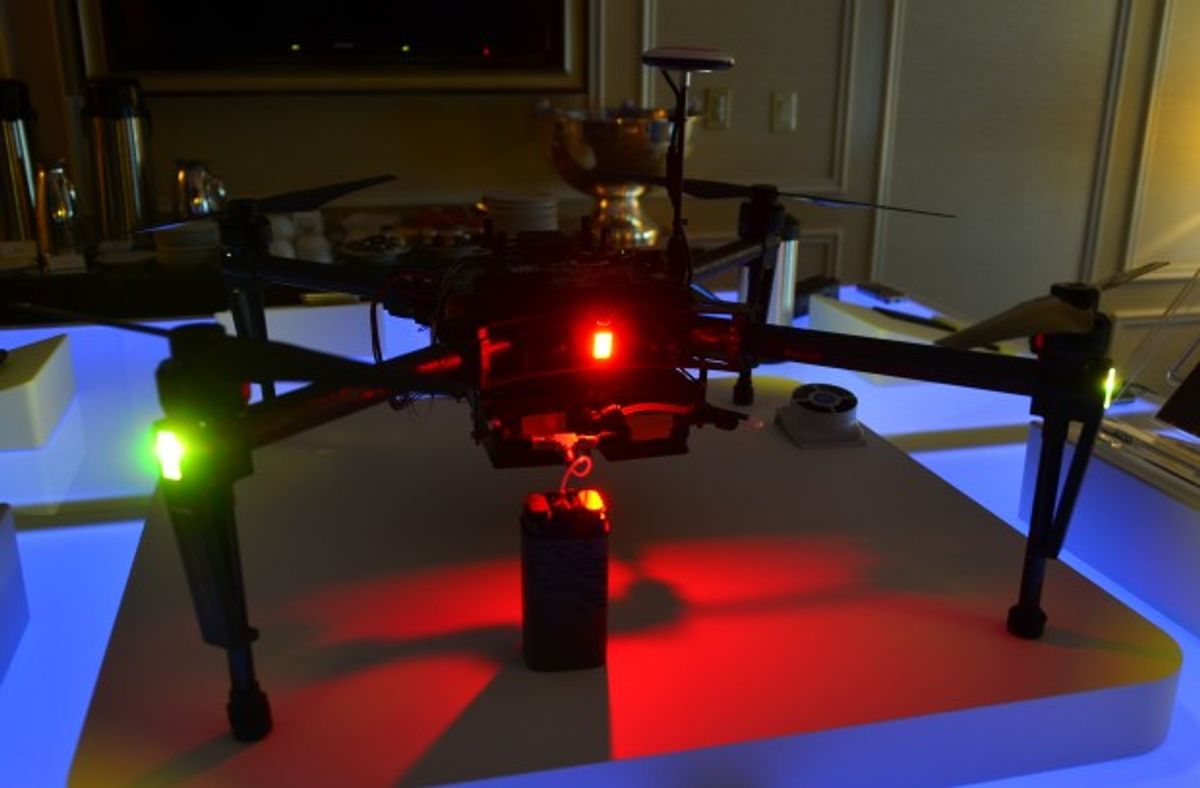Back in August, when we wrote about Intelligent Energy’s prototype fuel cell iPhone, we weren’t totally convinced that it was an idea that would catch on. We’re still not totally convinced, but yesterday at the Consumer Electronics Show in Las Vegas, we stopped by Intelligent Energy’s suite to check out the prototype ourselves, along with a fuel cell-powered MacBook and a drone that can fly for up to two hours on a small canister of hydrogen gas.
A hydrogen fuel cell generates electricity by combining hydrogen gas with oxygen in the air to create water vapor. It’s very efficient, and the energy density of the hydrogen fuel is extremely high. A fuel cell doesn’t directly store electricity, so we’re not going to do away with the battery anytime soon, but working in tandem with a small battery pack enables devices like cell phones to function for weeks on a relatively small amount of hydrogen.

The problem with hydrogen has always been distribution infrastructure. Intelligent Energy sells disposable canisters of hydrogen in the United Kingdom, where you can buy them at Apple stores and a few other places. I asked Intelligent Energy about the potential for small, in-home hydrogen filling stations, where you use electricity from the wall to crack water into a pair of Hs and an O. They’re pretty sure that this would just introduce an expensive extra burden on consumers.

I don’t entirely agree with Intelligent Energy on this. Personally, I have some kind of gut reaction against the idea of things that are disposable, and I’m not sure I like having to rely on going to a store to get fuel for my devices, even if it’s something that I have to do for my car (and my body, for that matter). I fully appreciate the energy density and portability of hydrogen, though, and I wish there was a way for me to take advantage of it more directly. There are a few companies who offer desktop kits that make hydrogen out of electricity from the wall and water, but they’re not really designed for consumers.
If we look more at the prosumer space, though, we can start to see where hydrogen could have an enormous impact, and that’s with drones. High power density is important for consumer electronics, for sure, but for drones, it’s the difference between flying and crashing. And it’s not like drones can just carry around extra battery packs, since doing so is counterproductive. Power is a huge restriction for drones right now, and not just in limiting range and payload: power also limits the amount of computing resources available, and with the increasing demand for both assistive and full autonomy, drones are sucking down more power than ever.

Consider delivery drones, for example: they need enough endurance to get from their home base to a customer and back again; they need to carry as large of a payload as possible while doing it; and they’re going to need a significant amount of sensing and autonomy. Hydrogen would allow drones to deliver a much wider array of items to a much higher number of customers, and perhaps just as important, when they return they can be refuled with more hydrogen in seconds and then sent right back out again. Intelligent Energy’s prototype drone (the one in the pictures) can fly for between 1 and 2 hours on a canister of gas.
On a commercial and industrial scale, the production and distribution of hydrogen is a bit simpler than on the consumer scale. Rather than relying on disposable cartridges, you just get your hydrogen delivered in bulk inside a cylinder, and then you send the cylinder back when it’s empty and get a new one.

So what does the future hold for hydrogen? I don’t know. For drones, it’s great. For places where reliable electricity doesn’t exist, it’s great. But for most consumers, it may still be more trouble than it’s worth. This could change if the automotive industry manages to spread a little bit more hydrogen infrastructure around, but batteries seem to be in favor at the moment, and we haven’t seen a whole lot of industry-wide development going into hydrogen vehicles.
Intelligent Energy is hoping to license its hydrogen fuel cells to manufacturers and OEMs to bring the technology to market in an integrated way, and, the company says, it’s “not far away” from showing up here in the United States.
Evan Ackerman is a senior editor at IEEE Spectrum. Since 2007, he has written over 6,000 articles on robotics and technology. He has a degree in Martian geology and is excellent at playing bagpipes.



